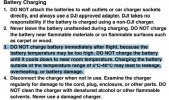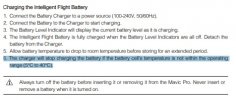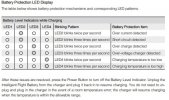Some good advice above.
I still have my original M1P flymore (3) batteries from 2017, still work perfectly, no swelling ever and seem to be as good as more recent (3) extras purchased over the last 2 years or so.
They are pretty much obsolete now.
I also have my original flymore Spark batteries (3) from about 2018, and (2) extras purchased just before they were made obsolete a couple of years ago, and all of those are also perfectly functioning as new.
My general rules are similar to much of the above advice, and might add a few more to clarify.
In no particular order, all are as important as the next.
1. Store at ~ 50%. Generally not hard, as the DJI 'smarts' will discharge a full battery to ~ that in X days (not sure what the
Air2/s does), that's as set in GO4 app (not sure about the Air Fly app, if you can set that, or if it does it in X days).
If I charge 6 batteries and only fly 3, I'll charge the 3 up to when the 3rd light starts blinking, then take them off and store.
The other 3, I will store and let them discharge automatically, or fly with them within the 5 days I have set for discharge.
If I fly any down to say just 70% or so, I will just store them and let then discharge automatically.
2. I try really REALLY hard not to land with less than 20% battery remaining, flying them too low is not good for them, certainly flying to 5% or less regularly is very bad for them.
3. Keep them cool ! You probably won't have too much of an issue in the UK, but if in a car on what you'd call a hot summers day, yeah, that can be bad for them long term.
4. Never charge a hot battery, straight from the drone flight, let them cool.
5. Never fly if a battery has entered auto discharge mode (you can see this in battery management window in GO4, not sure about Fly app), even if it shows a decent amount, say 3 to 3-1/2 lights, just recharge them.
6. Try and work inside the recommended DJI operating range, I think the upper and lower limit temps are there due mostly to battery performance / effect, eg. flying often on a hot day in sports mode will make the battery a lot hotter = reduced long term life . . . flight time if cold will likely be affected if battery is not warmed, so easy to fly to low %, and if done regularly this can also shorten battery life.
There might be other things I haven't managed to think about, but if you followed those general points, you should get good battery performance / longevity.
The DJI batteries are pretty hard to destroy, as compared to FPV soft lipo packs, just following points 1 to 4 above, and being aware of 4 and 5 will be enough to help prolong their life.
Charging, you are supposed to be right there to monitor them as they charge.
I don't, but do put them in a big stoneware casserole dish (your mum is going to love you for that), and then place on a stove top.
The stove has a hood air extractor above if a lipo fire ever happens, but I don't generally turn that on, just let them charge underneath that in case I detect a fire.
That's handy in case of lipo fire as the white smoke venting out is toxic Fluoride gas, plus it makes a mess.
Enjoy the
Air2S, should see some great improvements on the photo quality you were worried about on your other thread(s), practice composition techniques and your photos will be improving out of sight.














